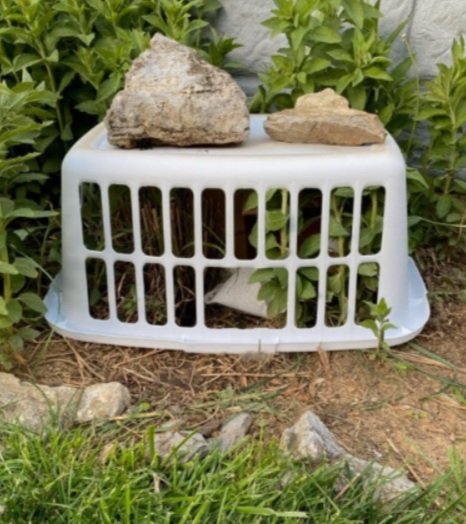
Help! I Found a Wild Rabbit!
Wild rabbits and hares are one of the most common mammals in North America. In Pennsylvania, our most common species is the Eastern Cottontail. We rescue hundreds of Eastern Cottontails every year and are here to help.
Remember: It is illegal to keep and raise wildlife
Myth: Rabbits will abandon their babies because you touched them
If You Find a Rabbit That:
Is larger than a softball (more than 100 grams or 4 ounces) and is able to run away from you
Is in a shallow depression in your yard/garden covered with fur
Freezes when approached by people
Had its nest disturbed while gardening but the babies are unharmed
This is normal! Babies less than the size of a softball should still be inside the nest. A disturbed nest can be reconstructed and covered with any remaining fur and surrounding vegetation. For more solutions to common problems with rabbits in human spaces, visit this page.
If You Find a Rabbit That:
Has been in a dog or cat’s mouth
Is bleeding or has been hit by a lawn mower
Has parasites, including fly eggs (look like little grains of rice)
Was hit by a car
Has its eyes closed, is found in the open with no nest or cover and you can’t find a nearby nest
This is an emergency. Receive immediate support here or contact your local wildlife rehabilitator.
How To Save Baby and Juvenile Rabbits
Young rabbits, called kits, are born mostly hairless and with their eyes closed. Their skin is greyish and their ears lay flat against their heads. Rabbits develop rabidly, and will open their eyes, grow fur and begin leaving the nest all by two weeks old. They will not venture far from the nest and will return at dawn and dusk to nurse from their mother. Rabbit kits have no scent, so mom will not be able to find them if they have moved from the nest.
By three weeks of age, the rabbits are fully weaned and are completely independent, despite not quite being full-sized yet.
In Pennsylvania and across the northeast United States, you can expect to see nests of baby bunnies beginning in early spring until late fall. “Breeding like rabbits” is no joke! A single adult Cottontail can have a new litter averaging five kits every month of the breeding season.
Keep an eye out! Nests are usually a small depression in the ground, around 5 inches deep. The mother will cover her kits with fur and vegetation to keep them concealed from predators. Cottontails are also happy to take over abandoned burrows of woodchucks. Mom will only visit the nest twice per day at dawn and dusk to feed the kits. Juvenile rabbits will leave the nest around two weeks old and are completely weaned by three/four weeks.
A wild rabbit’s nest found on the wildlife center’s property in 2019. One tell-tale-sign you have found a rabbit’s nest is a patch of dead grass covered in fur.
A peak inside reveals comfortable resting babies. If you find a rabbit’s nest, make sure to mark the area to remember its location while mowing or walking pets outside.
These kits should still be in the nest. Their eyes are beginning to open, but their fur is still slick to their bodies. Because they have no scent, mom will not be able to find them. Do NOT remove the bunnies or relocate the nest!
This juvenile is old enough to be on its own. Ears are up, fur is fluffy and he can run from predators. Unless he is injured, no intervention is needed. Juveniles often “freeze” when approach, which is a normal fear response.
Curious dogs can cause problems for baby rabbits, but you can help! The easiest solution is to take your dog to a different part of the yard. Another option is covering the nest (like seen above) or using temporary fencing to block your pet’s access to the nest while still allowing mom to come in and feed the babies overnight.
Not sure if mom is coming back? Mom only visits the nest two times per day, so it can be hard to tell. You may never see her! The best way to confirm is to set up a game camera or similar motion-activated camera pointed toward the nest. You can also check the young rabbits to see if they have full bellies (like this baby above) in the morning. Check once, then leave the nest alone until the babies leave.
How To Save Adult Rabbits
Young, independent rabbits (about the size of a softball) will often “freeze” when threatened. This is a normal fear response, and it is not uncommon for them to remain unmoving for hours at a time. Larger adult rabbits, when threatened, will freeze at first, then run away.
Adult rabbits are high stress! We cannot emphasize this enough. If you find an adult rabbit in need of help, keep the animal in a quiet, dark place. This can mean the difference between life and death!
If an adult rabbit cannot run away from you, this is an emergency! Capture the rabbit and contact a wildlife rehabilitator right away. To safely capture an adult rabbit, throw a towel over the animal and slide or place it into a secure box. Adult rabbits have powerful back legs that they use to defend themselves against chasing predators but are not known to bite or scratch.
For more solutions to common problems with rabbits in human spaces, visit this page.
Do you still have questions after reading the information above? Contact us or a local wildlife rehabilitator!
Have you found this FREE information helpful? Help support our work and expand our services by giving a gift.
Resources
Answering the Call of the Wild by Erin Luther. Toronto Wildlife Centre.
Behavior of North American Mammals by Mark Elbroch and Kurt Rinehart. Peterson Reference Guide.
Wild Neighbors: The Humane Approach to Living with Wildlife by John Hadidian. The Humane Society of the United States.









